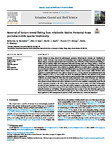Removal of bottom-towed fishing from whole-site Marine Protected Areas promotes mobile species biodiversity
| dc.contributor.author | Blampied, SR | |
| dc.contributor.author | Rees, Sian | |
| dc.contributor.author | Attrill, Martin | |
| dc.contributor.author | Binney, FCT | |
| dc.contributor.author | Sheehan, Emma | |
| dc.date.accessioned | 2022-10-28T11:13:09Z | |
| dc.date.available | 2022-10-28T11:13:09Z | |
| dc.date.issued | 2022-10-05 | |
| dc.identifier.issn | 0272-7714 | |
| dc.identifier.issn | 1096-0015 | |
| dc.identifier.other | 108033 | |
| dc.identifier.uri | http://hdl.handle.net/10026.1/19773 | |
| dc.description.abstract |
Marine habitats are being altered by anthropogenic pressures, influencing the diversity and distribution of species. Marine Protected Areas (MPAs) are increasingly used as spatial management tools to mitigate these human impacts on marine systems, but levels of protection vary. MPAs that exclude bottom-towed fishing activities from all habitats within their boundaries while still allowing static gear fishing, taking a “whole-site approach”, have shown benefits in terms of increasing biodiversity and biomass on reef habitat. In this study we use Baited Remote Underwater Videos (BRUVs) to quantify differences in mobile species assemblage composition, diversity and abundance on mixed sediment habitats inside and outside three MPAs adopting this whole-site approach within Jersey's territorial waters. Greater numbers of taxa were recorded within all three MPAs compared to nearby unprotected areas, with an average of 4.9 ± 1.8 taxa observed per deployment inside the MPAs compared to 3.9 ± 1.7 taxa outside the MPAs. No significant difference was observed in the overall abundance. The proportion of presence of two indicator species (Labridae Spp. and juvenile bream Spondyliosoma cantharus) was greater within the MPAs than the nearby unprotected areas. IUCN threatened and vulnerable shark species were observed on more BRUVs inside the MPAs, while IUCN threatened and vulnerable ray species were present on fewer BRUVs in the MPAs, but both occurred in too few numbers to statistically assess. Not all species responded positively to the MPAs, with scavenging species such as spider crab (Maja brachydactyla) recorded in lower numbers in two out of the three MPAs compared to the nearby unprotected areas. BRUV surveys that have been used to survey MPAs that exclude bottom-towed fishing in Europe are sparse and have primarily focussed on reef habitat. This study provides the first account of how this whole-site approach for mixed sediment habitats in three MPAs affects mobile species. These results evidence the merit of an ecosystem-based approach to MPA management for species of both conservation and commercial importance. | |
| dc.format.extent | 108033-108033 | |
| dc.language | en | |
| dc.language.iso | en | |
| dc.publisher | Elsevier BV | |
| dc.subject | Ecosystem-based approach | |
| dc.subject | Benthic ecology | |
| dc.subject | Fisheries | |
| dc.subject | Whole-site approach | |
| dc.subject | MPAs | |
| dc.subject | Mixed sediments | |
| dc.subject | Baited video camera | |
| dc.title | Removal of bottom-towed fishing from whole-site Marine Protected Areas promotes mobile species biodiversity | |
| dc.type | journal-article | |
| dc.type | Journal Article | |
| plymouth.author-url | https://www.webofscience.com/api/gateway?GWVersion=2&SrcApp=PARTNER_APP&SrcAuth=LinksAMR&KeyUT=WOS:000850142500004&DestLinkType=FullRecord&DestApp=ALL_WOS&UsrCustomerID=11bb513d99f797142bcfeffcc58ea008 | |
| plymouth.volume | 276 | |
| plymouth.publication-status | Published | |
| plymouth.journal | Estuarine, Coastal and Shelf Science | |
| dc.identifier.doi | 10.1016/j.ecss.2022.108033 | |
| plymouth.organisational-group | /Plymouth | |
| plymouth.organisational-group | /Plymouth/Faculty of Science and Engineering | |
| plymouth.organisational-group | /Plymouth/Faculty of Science and Engineering/School of Biological and Marine Sciences | |
| plymouth.organisational-group | /Plymouth/PRIMaRE Publications | |
| plymouth.organisational-group | /Plymouth/REF 2021 Researchers by UoA | |
| plymouth.organisational-group | /Plymouth/REF 2021 Researchers by UoA/UoA07 Earth Systems and Environmental Sciences | |
| plymouth.organisational-group | /Plymouth/REF 2021 Researchers by UoA/UoA14 Geography and Environmental Studies | |
| plymouth.organisational-group | /Plymouth/Users by role | |
| plymouth.organisational-group | /Plymouth/Users by role/Academics | |
| dcterms.dateAccepted | 2022-08-12 | |
| dc.rights.embargodate | 2022-10-29 | |
| dc.identifier.eissn | 1096-0015 | |
| dc.rights.embargoperiod | Not known | |
| rioxxterms.versionofrecord | 10.1016/j.ecss.2022.108033 | |
| rioxxterms.licenseref.uri | http://www.rioxx.net/licenses/all-rights-reserved | |
| rioxxterms.type | Journal Article/Review |


